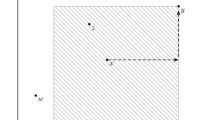Abstract
Parties face a trade-off between motivating partisans to participate in the election and appealing to issue-oriented middle-of-the-road voters. We show that, consequently, parties may diverge from the median voters’ preferred policy by sending ambiguous messages to voters which include announcements of alternative platforms. Moreover, surprisingly, an increase in the size of a partisan constituency may lead to platform convergence towards the median voters’ preferred policy. We identify two conditions for this outcome. First, the electorate is sufficiently divided such that full convergence does not occur and, second, the majority of the non-partisan voters is more inclined to the party with increased support of partisans.
Similar content being viewed by others
References
Abramowitz, A. I., & Saunders, K. L. (1998). Ideological realignment in the US electorate. Journal of Politics, 60, 634–652.
Adams, J., & Merrill, S. (2003). Voter turnout and candidate strategies in American elections. Journal of Politics, 65, 161–189.
Alesina, A. (1988). Credibility and policy convergence in a two-party system with rational voters. American Economic Review, 78, 796–805.
Alesina, A., & Cukierman, A. (1990). The politics of ambiguity. Quarterly Journal of Economics, 105, 829–850.
Aragones, E., & Palfrey, T. R. (2002). Mixed equilibrium in a Downsian model with a favored candidate. Journal of Economic Theory, 103, 131–161.
Ashworth, S. (2006). Campaign finance and voter welfare with entrenched incumbents. American Political Science Review, 100, 55–68.
Ashworth, S., & Bueno de Mesquita, E. (2009). Elections with platform and valence competition. Games and Economic Behavior, 67, 191–216.
Calvert, R. L. (1985). Robustness of the multidimensional voting model: candidate motivations, uncertainty, and convergence. American Journal of Political Science, 29, 69–95.
Campbell, A., Converse, P., Miller, W., & Stokes, D. (1960). The American Voter. Chicago: University of Chicago Press.
Carrillo, J. D., & Castanheira, M. (2008). Information and strategic political polarization. Economic Journal, 118, 845–874.
Coate, S. (2004). Pareto improving campaign finance policy. American Economic Review, 94, 628–655.
Cukierman, A., & Tommasi, M. (1998a). When does it take a Nixon to go to China? American Economic Review, 88, 180–197.
Cukierman, A., & Tommasi, M. (1998b). Credibility of policymakers and of economic reforms:. In F. Sturzenegger & M. Tommasi (Eds.), The Political Economy of Reform. Cambridge: MIT Press.
Dixit, A., & Londregan, J. (1998). Ideology, tactics, and efficiency in redistributive politics. Quarterly Journal of Economics, 113, 497–529.
Downs, A. (1957). An Economic Theory of Democracy. New York: Harper & Row.
Eyster, E., & Kittsteiner, T. (2007). Party platforms in electoral competition with heterogeneous constituencies. Theoretical Economics, 2, 41–70.
Glaeser, E. L., & Ward, B. A. (2006). Myths and realities of American political geography. Journal of Economic Perspectives, 20, 119–144.
Glaeser, E. L., Ponzetto, G. A. M., & Shapiro, J. M. (2005). Strategic extremism: why Republicans and Democrats divide on religious values. Quarterly Journal of Economics, 120, 1283–1330.
Greene, S. (2004). Social identity theory and party identification. Social Science Quarterly, 85, 136–153.
Groseclose, T. J. (2001). A model of candidate location when one voter has a valence advantage. American Journal of Political Science, 45, 862–886.
Grossman, G. M., & Helpman, E. (1996). Electoral competition and special interest politics. Review of Economic Studies, 63, 265–286.
Grossman, G. M., & Helpman, E. (2001). Special Interest Politics. Cambridge: MIT Press.
Herrera, H., Levine, D. K., & Martinelli, C. (2008). Policy platforms, campaign spending and voter participation. Journal of Public Economics, 92, 501–513.
Houser, D., & Stratmann, T. (2008). Selling favors in the lab: experiments on campaign finance reform. Public Choice, 136, 215–239.
Kimball, D. C., & Gross, C. A. (2007). The growing polarization of American voters. In J.C. Green (Ed.), The State of Parties (pp. 265–278). Boulder: Rowman & Littlefield.
Laslier, J. (2000). Interpretation of electoral mixed strategies. Social Choice and Welfare, 17, 283–292.
McCarty, N., Poole, K. T., & Rosenthal, H. (2006). Polarized America: The Dance of Ideology and Unequal Riches. Cambridge: MIT Press.
Miller, G., & Schofield, N. J. (2003). Activists and partisan realignment in the United States. American Political Science Review, 97, 245–260.
Olson, M. (1982). The Rise and Decline of Nations. New Haven: MIT Press.
Persson, T., & Tabellini, G. (2000). Political Economics: Explaining Economic Policy. Cambridge: MIT Press.
Plane, D. L., & Gershtenson, J. (2004). Candidates’ ideological locations, abstention, and turnout in U.S. midterm senate elections. Political Behavior, 26, 69–93.
Prat, A. (2002). Campaign advertising and voter welfare. Review of Economic Studies, 69, 999–1018.
Roemer, J. (1997a). Political-economic equilibrium when parties represent constituents: the unidimensional case. Social Choice and Welfare, 14, 479–502.
Roemer, J. (1997b). The democratic political economy of progressive income taxation. Econometrica, 67, 1–19.
Schofield, N. J. (2003). Valence competition in the spatial stochastic model. Journal of Theoretical Politics, 15, 371–383.
Schreckhise, W. D., & Shields, T. G. (2003). Ideological realignment in the contemporary U.S. electorate revisited. Social Science Quarterly, 84, 596–612.
Shachar, R. (2003). Party loyalty as habit formation. Journal of Applied Econometrics, 18, 251–269.
Stratmann, T. (2005). Some talk: money in politics. A (partial) review of the literature. Public Choice, 124, 135–156.
Stratmann, T. (2006). Contribution limits and the effectiveness of campaign spending. Public Choice, 129, 461–74.
Stratmann, T., & Aparicio-Castillo, F. J. (2006). Competition policy for elections: do campaign contribution limits matter? Public Choice, 127, 177–206.
Wittman, D. (1983). Candidate motivation: a synthesis of alternative theories. American Political Science Review, 77, 142–157.
Zakharov, A. (2009). A model of candidate location with endogenous valence. Public Choice, 138, 347–366.
Zipp, J.F. (1985). Perceived representatives and voting: an assessment of the impact of “choices” vs. “echoes”. American Political Science Review, 79, 50–61.
Author information
Authors and Affiliations
Corresponding author
Rights and permissions
About this article
Cite this article
Blumkin, T., Grossmann, V. May increased partisanship lead to convergence of parties’ policy platforms?. Public Choice 145, 547–569 (2010). https://doi.org/10.1007/s11127-009-9579-8
Received:
Accepted:
Published:
Issue Date:
DOI: https://doi.org/10.1007/s11127-009-9579-8



